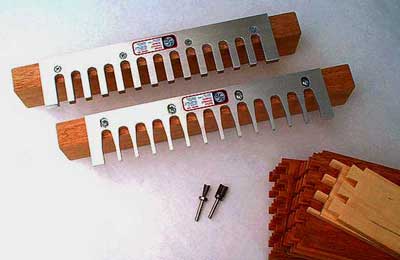
David Keller has advice for all of you woodworkers out there. “Be careful what you come up with in your shop, because that’s what you may end up doing for your career,” he warns. David knows a lot about that. Many years ago, he was working in Art Carpenter’s shop and was given the task of creating some new dovetail jigs for particularly thick stock that was part of a project they were working on. He drew up some plans for a new dovetail jig that turned into a product that turned into a business (Keller and Co., Petaluma, California) with David at the helm. His company is celebrating its 25th anniversary next year and has enjoyed more success than he ever anticipated.
The whole thing started innocently enough, explains David. He decided to make the new dovetail jigs for the router out of metal. So, drawing on his high school drafting experience, he made some blueprints and submitted them to a local machinist. The metal worker told him that it looked like a simple project, but he asked him “Don’t you have any friends?” ? because once the machine was set up, making a dozen of these jigs would cost just about the same as making the two that David had requested. He did have some friends in the Balinas Craftsman Guild, and so the first run turned out 16 prototype dovetail router jigs.
Not a Marketing Guy
While there were a lot of blind dovetail jigs available, this was the first “through” dovetail jig that anyone knew of. The design included a bearing for the shaft of the bit, and that was another first. Later, as David continued to receive input and improvements from friends and customers, he helped design the first pattern router bits. When customers started requesting more jigs than furniture, and after a lot of encouragement during the Los Angeles Machinery Show, he said, “Well, it looks like a business.”
It’s a business that David has had an uneasy alliance with. For the most part, he’s really loved building jigs that help woodworkers cut perfect dovetails easily. A few years back, however, he was feeling a little burned out on the whole thing and wondered to himself why he was spending so much time and energy telling woodworkers what they should buy. It felt artificial to be selling woodworking tools. He was himself, after all, just a woodworker. He wasn’t a marketing guy.
Before he decided to chuck it all, however, he went to one last trade show with the mission of just listening to customers. What he heard was inspiring. Customers would tell him how his jig was their favorite tool, how it was the most used tool in their shop and how cool it was that the tool did precisely what it claimed it would do. “My sense about tools is that tools have to do what they say they are going to do and then get out of the way ? so working with the tools is essentially transparent,” says David. Listening to customers about his jigs was enough to keep him going.
Are We Losing Focus?
There are, however, issues in the woodworking industry that continue to bother him. He’s very concerned that, since the blossoming of the hobbyist woodworker, the woodworking community has lost its focus. He goes to shows and sees “a parade of tools and devices and jigs and fixtures, some of which have been useful, some of which are somebody’s eccentric solution to a universal problem, and then there’s lots of things that are just being marketed as toys,” says David.
And a focus on the fundamentals of woodworking ? in favor of gee-whiz gadgets ? is declining, according to David. In the past, he would get a call every three or four months from a woodworker who was having dovetails break off because he was cutting them cross-grain. Now the same call happens every three to four weeks. And the woodworkers don’t understand what he means when he uses terms like “cross grain.” The focus should be, he says, on four questions:
1. What am I doing?
2. How can I do it more effectively?
3. How can I learn to do it better?
4. How can I learn to do it and have fun?
He is very concerned that woodworking skills and knowledge are falling prey to an emphasis on the tools themselves instead of the woodworking tasks that need to be accomplished. “The fascination with the tool market has really distorted how woodworking is paid attention to and supported,” says David. Combine that with the decline in high school shop classes and parent-to-child woodworking knowledge transfer and, he says, there are many reasons to be concerned about the future of woodworking.
And the first step to changing that trend, he says, is admitting what we don’t know and what we need to learn. “We’re in this to learn and to do better jobs and do better woodworking, and the only way to do that is admit what you don’t know,” says David.





